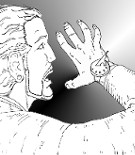Speech balloon (nonfiction): Difference between revisions
From Gnomon Chronicles
(Created page with "thumb|Hieroglyph for "grain" (see [[Pefsu problem), which resembles a speech balloon.]]'''Speech balloons''' (also speech bubbles, dialogue ballo...") |
No edit summary |
||
| Line 9: | Line 9: | ||
== Nonfiction cross-reference == | == Nonfiction cross-reference == | ||
* [[Cartouche]] | * [[Cartouche (nonfiction)]] | ||
* [[Hieroglyph-grain.jpg Hieroglyph for grain]] | |||
== Fiction cross-reference == | == Fiction cross-reference == | ||
| Line 17: | Line 18: | ||
* [https://en.wikipedia.org/wiki/Speech_balloon Speech balloon] @ Wikipedia | * [https://en.wikipedia.org/wiki/Speech_balloon Speech balloon] @ Wikipedia | ||
[[Category: | [[Category:Nonfiction (nonfiction)]] | ||
[[Category: | [[Category:Art (nonfiction)]] | ||
Revision as of 05:18, 31 May 2016

Hieroglyph for "grain" (see Pefsu problem), which resembles a speech balloon.
Speech balloons (also speech bubbles, dialogue balloons or word balloons) are a graphic convention used most commonly in comic books, comics, and cartoons to allow words (and much less often, pictures) to be understood as representing the speech or thoughts of a given character in the comic.
Description
There is often a formal distinction between the balloon that indicates thoughts and the one that indicates words spoken aloud.
The balloon that conveys subjective thoughts is often referred to as a thought bubble.
Nonfiction cross-reference
Fiction cross-reference
External links
- Speech balloon @ Wikipedia
